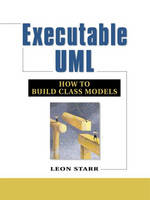
Executable UML
Prentice Hall (Verlag)
978-0-13-067479-1 (ISBN)
- Titel ist leider vergriffen;
keine Neuauflage - Artikel merken
For all software engineering courses on UML, object-oriented analysis and modeling, and analysis/modeling for real-time or embedded software.
Executable UML is for students who want to apply object-oriented analysis and modeling techniques to real-world UML projects. Leon Starr presents the skills and techniques needed to build useful class models for creating precise, executable software specifications that generate target code in multiple languages and for multiple platforms. Leon, who wrote the definitive guide to Shlaer-Mellor modeling, emphasizes the practical use of executable UML modeling, presenting extensive examples from real-time embedded and scientific applications. Using the materials in his How to Build Shlaer-Mellor Object Models as a starting point, Leon presents an entirely new introduction to Executable UML, expresses all diagrams in Executable UML notation, and adds advanced new object modeling techniques.
LEON STARR has been developing real-time and embedded software with executable models since 1985. His models have been used in factory material transport control systems, ultrasound diagnostic and cardiac pacing systems, gas chromatography and semiconductor wafer inspection systems, video post-production systems, and networked military battle simulators. The author of How to Build Shlaer-Mellor Object Models and Executable UML: A Case Study, he is a founding member and senior consultant at Model Integration, LLC in San Francisco, CA.
1. Classes.
2. Attributes.
3. Associations And Relationships.
4. Binary Associations.
5. Association Classes.
6. Basic Specialization-Generalization Relationships.
7. Advanced Generalization Relationships.
8. Constraints On Association And Relationships.
9. How to Avoid Model Hacking.
10. Why Write Model Descriptions.
11. How to Write Class Descriptions.
12. How to Write Attribute Descriptions.
13. How to Write Association Descriptions.
14. Why Do We Limit Ourselves to 0, 1 and *?.
15. Reflexive Patterns.
16. Network Patterns.
17. Linear Patterns.
18. Tree Patterns.
| Erscheint lt. Verlag | 8.1.2002 |
|---|---|
| Verlagsort | Upper Saddle River |
| Sprache | englisch |
| Maße | 177 x 234 mm |
| Gewicht | 829 g |
| Themenwelt | Informatik ► Software Entwicklung ► Objektorientierung |
| Mathematik / Informatik ► Informatik ► Web / Internet | |
| ISBN-10 | 0-13-067479-6 / 0130674796 |
| ISBN-13 | 978-0-13-067479-1 / 9780130674791 |
| Zustand | Neuware |
| Haben Sie eine Frage zum Produkt? |
aus dem Bereich


